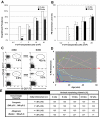Early chimerism threshold predicts sustained engraftment and NK-cell tolerance in prenatal allogeneic chimeras
- PMID: 18796629
- PMCID: PMC2597617
- DOI: 10.1182/blood-2007-12-128116
Early chimerism threshold predicts sustained engraftment and NK-cell tolerance in prenatal allogeneic chimeras
Abstract
The failure of engraftment in human cases of in utero hematopoietic cell transplantation (IUHCT) in which no immunodeficiency exists suggests the presence of an unrecognized fetal immune barrier. A similar barrier in murine IUHCT appears to be dependent on the chimerism level and is poorly explained by a lack of T-cell tolerance induction. Therefore, we studied the effect of the chimerism level on engraftment and host natural killer (NK)-cell education in a murine model of IUHCT. The dose of transplanted cells was found to exhibit a strong correlation with both the engraftment rate and chimerism level. More specifically, a threshold level of initial chimerism (> 1.8%) was identified that predicted durable engraftment for allogeneic IUHCT, whereas low initial chimerism (< 1.8%) predicted a loss of engraftment. NK cells taken from chimeras above the "chimerism threshold" displayed durable calibration of alloresponsive Ly49A receptors and tolerance to donor antigens. Depletion of recipient NK cells stabilized engraftment in low-level chimeras (< 1.8%). These studies illustrate the importance of the early chimerism threshold in predicting long-term engraftment and host NK-cell tolerance after in utero transplantation.
Figures






Comment in
-
Transplantation NK'Oed in the first trimester.Blood. 2008 Dec 15;112(13):4790-1. doi: 10.1182/blood-2008-10-183178. Blood. 2008. PMID: 19064738 No abstract available.
Similar articles
-
Prenatal transplantation of cytokine-stimulated marrow improves early chimerism in a resistant strain combination but results in poor long-term engraftment.Exp Hematol. 2006 Sep;34(9):1278-87. doi: 10.1016/j.exphem.2006.05.007. Exp Hematol. 2006. PMID: 16939821 Free PMC article.
-
CD26 inhibition enhances allogeneic donor-cell homing and engraftment after in utero hematopoietic-cell transplantation.Blood. 2006 Dec 15;108(13):4268-74. doi: 10.1182/blood-2006-04-018986. Epub 2006 Sep 5. Blood. 2006. PMID: 16954501 Free PMC article.
-
Infusion of Host-Derived Unlicensed NK Cells Improves Donor Engraftment in Non-Myeloablative Allogeneic Hematopoietic Cell Transplantation.Front Immunol. 2021 Jan 7;11:614250. doi: 10.3389/fimmu.2020.614250. eCollection 2020. Front Immunol. 2021. PMID: 33488624 Free PMC article.
-
Hematopoietic cell transplantation for the induction of allo- and xenotolerance.Clin Transplant. 1996 Aug;10(4):357-63. Clin Transplant. 1996. PMID: 8884109 Review.
-
In utero hematopoietic stem cell transplantation: progress toward clinical application.Biol Blood Marrow Transplant. 2008 Jul;14(7):729-40. doi: 10.1016/j.bbmt.2008.02.012. Epub 2008 Apr 25. Biol Blood Marrow Transplant. 2008. PMID: 18541191 Review.
Cited by
-
Does the immune system induce labor? Lessons from preterm deliveries in women with autoimmune diseases.Clin Rev Allergy Immunol. 2010 Dec;39(3):194-206. doi: 10.1007/s12016-009-8180-8. Clin Rev Allergy Immunol. 2010. PMID: 19844811 Review.
-
Maternal T cells limit engraftment after in utero hematopoietic cell transplantation in mice.J Clin Invest. 2011 Feb;121(2):582-92. doi: 10.1172/JCI44907. Epub 2011 Jan 18. J Clin Invest. 2011. PMID: 21245575 Free PMC article.
-
Partial rescue of mucopolysaccharidosis type VII mice with a lifelong engraftment of allogeneic stem cells in utero.Congenit Anom (Kyoto). 2015 Feb;55(1):55-64. doi: 10.1111/cga.12099. Congenit Anom (Kyoto). 2015. PMID: 25421592 Free PMC article.
-
Maternal microchimerism in patients with biliary atresia: Implications for allograft tolerance.Chimerism. 2012 Apr-Jun;3(2):37-9. doi: 10.4161/chim.20152. Epub 2012 Apr 1. Chimerism. 2012. PMID: 22772071 Free PMC article.
-
Transplant Tolerance Induction in Newborn Infants: Mechanisms, Advantages, and Potential Strategies.Front Immunol. 2016 Apr 7;7:116. doi: 10.3389/fimmu.2016.00116. eCollection 2016. Front Immunol. 2016. PMID: 27092138 Free PMC article. Review.
References
-
- Muench MO. In utero transplantation: baby steps towards an effective therapy. Bone Marrow Transplant. 2005;35:537–547. - PubMed
-
- Muench MO, Barcena A. Stem cell transplantation in the fetus. Cancer Control. 2004;11:105–118. - PubMed
-
- Shields LE, Gaur L, Delio P, Potter J, Sieverkropp A, Andrews RG. Fetal immune suppression as adjunctive therapy for in utero hematopoietic stem cell transplantation in nonhuman primates. Stem Cells. 2004;22:759–769. - PubMed
-
- Shields LE, Gaur LK, Gough M, Potter J, Sieverkropp A, Andrews RG. In utero hematopoietic stem cell transplantation in nonhuman primates: the role of T cells. Stem Cells. 2003;21:304–314. - PubMed
-
- Crombleholme TM, Langer JC, Harrison MR, Zanjani ED. Transplantation of fetal cells [review]. Am J Obstet Gynecol. 1991;164:218–230. - PubMed
Publication types
MeSH terms
Substances
Grants and funding
LinkOut - more resources
Full Text Sources

